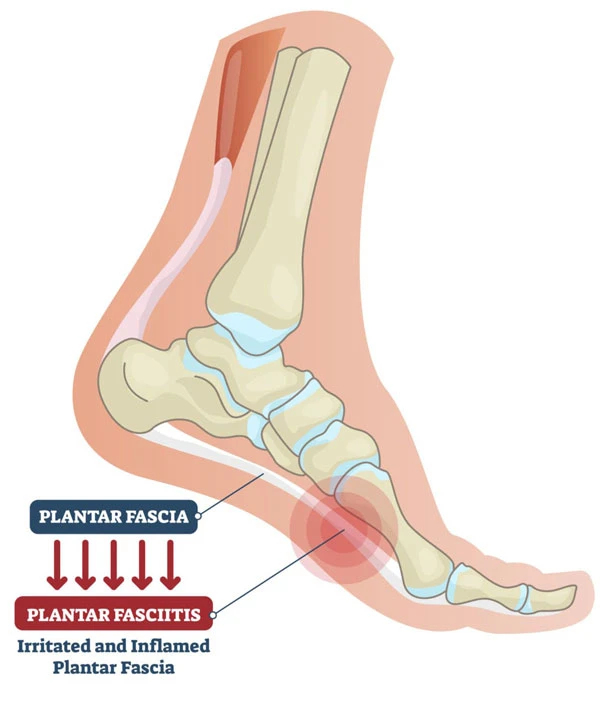What is Plantar Fasciitis?

Plantar fasciitis is a common foot condition that causes pain in the heel and bottom of the foot. It is often seen in people who are on their feet for long periods of time such as runners, athletes, and those who work in jobs that require standing. The condition is caused by inflammation of the plantar fascia a band of tissue that runs along the bottom of the foot and connects the heel bone to the toes.
Symptoms of Plantar Fasciitis
The most common symptom of plantar fasciitis is heel pain which is often worst in the morning when you first get out of bed. The pain may also be worse after standing or sitting for a long time or after intense physical activity. Other symptoms of plantar fasciitis may include:
- Pain in the heel and bottom of the foot
- Stiffness in the foot and heel
- Swelling in the foot and heel
- Difficulty walking or standing for long periods of time
Diagnosing Plantar Fasciitis
If you are experiencing heel pain and suspect, you may have plantar fasciitis. it is important to see a healthcare provider for a proper diagnosis. Your healthcare provider will ask about your symptoms and medical history and may perform a physical examination of your feet. They may also order imaging tests, such as an X-ray or MRI to get a better look at the structure of your feet and rule out other potential causes of heel pain.
Causes of Plantar Fasciitis
There are several factors that can contribute to the development of plantar fasciitis, including:
Overuse: Plantar fasciitis is often the result of repetitive strain on the plantar fascia which can be caused by activities such as running, dancing, or standing for long periods of time.
Poor footwear: Wearing shoes that do not provide sufficient arch support or cushioning can put extra strain on the plantar fascia leading to the development of plantar fasciitis.
Age: Plantar fasciitis is more common in people over the age of 40. As we age the plantar fascia can become less elastic making it more prone to injury.
Foot structure: People with flat feet or high arches are more prone to plantar fasciitis. This is because these foot types place extra strain on the plantar fascia.
Weight: Being overweight or obese can put extra strain on the feet and increase the risk of plantar fasciitis.
Tight calf muscles: Tight calf muscles can cause the foot to point downward putting extra strain on the plantar fascia.
Treatment for Plantar Fasciitis
Treatment for plantar fasciitis often involves a combination of rest, stretching, and physical therapy. Some people may find relief with over-the-counter pain medications such as ibuprofen or acetaminophen. Other treatment options may include:
Stretching: Stretching the calf muscles and the plantar fascia can help reduce pain and improve flexibility. Some people find relief with daily stretches while others may need to stretch more frequently.
Physical therapy: A physical therapist can teach you exercises to strengthen the muscles in your feet and lower legs which can help reduce pain and improve mobility.
Orthotic inserts: Shoe inserts or arch supports can help alleviate the strain on the plantar fascia and provide extra support for the feet.
Night splints: Wearing a night splint while you sleep can help stretch the plantar fascia and calf muscles reducing pain in the morning.
Corticosteroid injections: In some cases, corticosteroid injections may be recommended to reduce inflammation and pain.
Surgery: In severe cases of plantar fasciitis surgery may be necessary to release the plantar fascia or remove any bone spurs that may be causing pain.
Preventing Plantar Fasciitis
There are several steps you can take to help prevent plantar fasciitis, including:
Wearing supportive shoes: It is important to wear shoes that provide proper support for your feet and ankles. Shoes with good arch support and cushioning can help reduce the strain on the plantar fascia.
Stretching: Regular stretching of the calf muscles and plantar fascia can help keep them flexible and reduce the risk of injury.
Maintaining a healthy weight: Carrying excess weight puts extra strain on the feet and can increase the risk of plantar fasciitis. Maintaining a healthy weight can help reduce the risk of developing this condition.
Avoiding high heels: High heels place extra strain on the plantar fascia and can increase the risk of plantar fasciitis. Wearing shoes with a low heel or flat sole can help reduce the risk of this condition.
Using orthotic inserts: If you have flat feet or high arches orthotic inserts can provide extra support for your feet and help reduce the strain on the plantar fascia.
Taking breaks: If you are on your feet for long periods of time it is important to take breaks and rest your feet to reduce the risk of plantar fasciitis.
Gradually increase physical activity: If you are starting a new exercise program or increasing your physical activity level it is important to do so gradually to give your feet time to adjust. Sudden increases in activity can increase the risk of plantar fasciitis.
Conclusion
Plantar fasciitis is a common foot condition that causes pain in the heel and bottom of the foot. It is often seen in people who are on their feet for long periods of time such as runners and those who work in jobs that require standing. The condition is caused by inflammation of the plantar fascia, a band of tissue that runs along the bottom of the foot. Treatment for plantar fasciitis often involves a combination of rest, stretching, and physical therapy.
In severe cases, surgery may be necessary. To help prevent plantar fasciitis it is important to wear supportive shoes, stretch regularly, maintain a healthy weight and take breaks if you are on your feet for long periods of time. If you are experiencing heel pain and suspect, you may have plantar fasciitis it is important to see a healthcare provider for a proper diagnosis and treatment plan.

